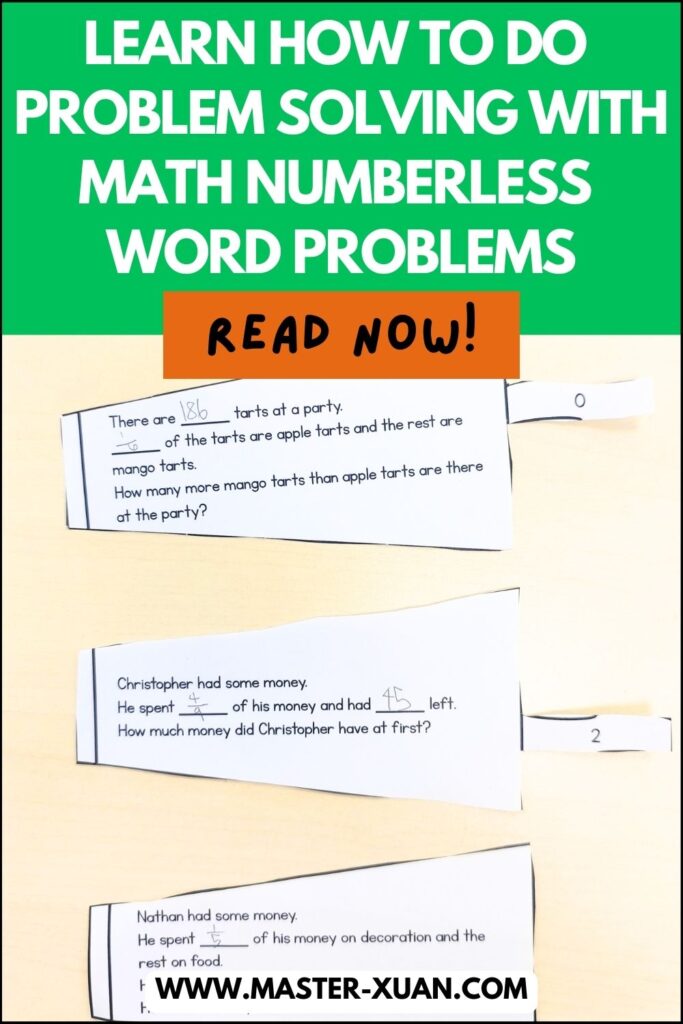Are you looking for ways to teach students how not to just guess the operation when doing problem solving with math word problems? Numberless word problems may be the solution.
By stripping away the numbers, we challenge students to truly understand the problem’s context and the actions involved, rather than relying on quick calculations.
I never knew about numberless word problems until I started teaching. If this is also new to you, let us embark on this learning journey together.
In this blog post, we’ll explore what exactly numberless word problems are, why we use them, how they help in problem solving with math word problems, and how to implement them.
What are Numberless Word Problems?
Unlike traditional word problems, numberless word problems don’t include specific numerical values.
One very obvious type is the word problems leave out the numbers, leaving a blank space where the numbers are supposed to be.
If you want computation of numbers, you will need to provide your set of numbers to the students.
For example: There were _ cats. If each cat caught _ rats, how many rats were caught?
Another type is the questions do not even have space for numbers.
For example: You are waiting in line and don’t know if it was worth it. How much longer did you wait in line than ride on the roller coaster?
Why Use Numberless Word Problems?
- Enhanced Problem-Solving Skills: By removing the numerical constraints, students can concentrate on the problem’s core and develop a variety of strategies to solve it.
- Deeper Conceptual Understanding: Numberless word problems foster a deeper understanding of mathematical concepts as students shift the focus from solving to understanding.
- Increased Engagement: The open-ended nature of numberless word problems can captivate students’ curiosity and motivate them to actively participate in the learning process.
- Differentiated Instruction: These problems can be adapted to meet the needs of diverse learners, allowing for both challenge and support. For example, students who are struggling with computation skills can now think about the problem with numbers that are comfortable to them.
How to Use Numberless Word Problems in Your Classroom
- Introduce the Concept: Begin by explaining the concept of numberless word problems and their benefits.
- Pose a Problem: Present a numberless word problem that aligns with your current math unit. Encourage students to read the problem carefully and identify the key information.
- Facilitate Discussion: Create a collaborative learning environment where students can share their thoughts, ideas, and strategies. Encourage them to ask questions and justify their reasoning. Ask purposeful questions such as, “What math do you see in this problem?”, “So what does that tell us?”, and “What is the possible range of values?”.
- Model Different Approaches: Demonstrate various strategies for solving the problem, such as drawing diagrams, using manipulatives, or writing equations.
- Encourage Student Exploration: Provide students with ample time to explore different solution paths and experiment with different strategies.
- Reflect and Share: Facilitate a class discussion where students share their solutions and explain their thinking process. This helps students learn from each other and develop a deeper understanding of the problem.
- Ask students what type of questions can the story ask: Ask students to guess what is the question you prepared. For example: “So what question could I ask you about this situation?” Have a discussion about the possible questions.
- Provide a few sets of numbers: After the understanding, it’s time for computation. Provide 3-5 sets of numbers with different difficulty ranges (i.e. 2-digits, 4-digits, decimals) for students to choose from to insert into the problem and solve. You can continue the discussion before the actual calculation by asking “What new information do you see? How does it change your understanding of the situation?”
Example Of Numberless Word Problem Progression:
- No numbers in the word problem.
- Add 1 value in the word problem.
- Reveal all the values of the word problem.
- Reveal the question.
By removing the question sentence, students only had to make sense of a part of the story at a time.
Here’s an example:
- I bought some red apples and some green apples.
- I bought 4 red apples and some green apples.
- I bought 4 red apples and 3 green apples.
- I bought 4 red apples and 3 green apples. How many apples did I buy?
If you want a case study of how it works in a classroom, read this: https://numberlesswp.com/how-do-they-work/
Final Thoughts
By using numberless word problems, you can empower your students to become critical thinking problem solvers.
If you want a quick activity to do with the numberless word problems task cards, ask them to sort them by the operation that they would use to solve the problem.
Give it a try and see if you are able to catch any misconception your students have been hiding!
If you need some FREE numberless word problems slides, check out https://numberlesswp.com/problem-banks/.
Or grab these New Year Numberless Word Problems Crafts:

Related Read: How Fantastic 3D Autumn Crafts Printable Make Word Problems Interesting
Here are some pins that you can save to bookmark this post. Save them to your Pinterest Board now! ↓







